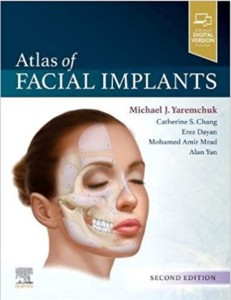Advancements in Facial Implants
 When I started practicing medicine in the 1980s, the year 2020 evoked futuristic images of cyborgs and interstellar travel. Now, 2020 is upon us and – while we still don’t have flying cars or robot housekeepers – technology has enabled major advancements in craniofacial implants. As we embark on a new decade, it’s an appropriate time to reflect on the advancements in plastic surgery in the last 10 years. This fall, the second edition of my book Atlas of Facial Implants was published, detailing the latest in aesthetic and reconstructive applications of alloplastic implants for recontouring the craniofacial skeleton.
When I started practicing medicine in the 1980s, the year 2020 evoked futuristic images of cyborgs and interstellar travel. Now, 2020 is upon us and – while we still don’t have flying cars or robot housekeepers – technology has enabled major advancements in craniofacial implants. As we embark on a new decade, it’s an appropriate time to reflect on the advancements in plastic surgery in the last 10 years. This fall, the second edition of my book Atlas of Facial Implants was published, detailing the latest in aesthetic and reconstructive applications of alloplastic implants for recontouring the craniofacial skeleton.
Here are four of the most important advancements:
1. Designer faces
The advent of computer-assisted implant design and manufacture has revolutionized implant design and use. I use precise measurements taken from CT scans of a patient’s skeletal structure to craft implants custom fit to the patient’s personal aesthetic goals using CAD/CAM technology. Leveraging CAD/CAM tools enables more effective surgical planning, exact implant design, and bespoke outcomes. It also helps avoid typical problems related to implant fit that can occur with traditional off-the-shelf implants.
2. Rejuvenation of the aging face and skeleton with implants
With age, the skin and soft tissue of the face change – stretching, sagging, and loosing volume. In the past, facial surgeries to restore youthful appearance focused on pulling the skin tight in an effort to restore youthful positioning of the soft tissue. This approach, however, does not produce natural-looking results. Fat grafts and fillers can be used to reposition the soft tissue of the face but will created a rounded look and will ultimately shift over time unless appropriately paired with a facial implant. With proper evaluation and aesthetic judgment, soft and hard tissue augmentation can be used together to restore youthful soft tissue positioning that strikes the right balance between softness and angularity.
3. Functional cranial implants
Custom designed cranial implants offer critical advancements not only for reconstructive surgery but also for aesthetic enhancements. In addition, implantable neuromodulation devices to treat central nervous system (CNS) diseases such as movement disorders, epilepsy, hydrocephalus, and chronic pain can utilize the “dead space” within these implants to house these devices. The traditional method of placement requires device positioning above the skull which produces a visible deformity and compromise the vascularity of the overlying scalp, often resulting in device exposure and loss. The innovative technique using CAD/CAM custom implants for a more exact fit and alternative, less obtrusive, fixation methods detailed in the Atlas addresses these issues.
4. Correction after orthognathic surgery
For too many orthognathic surgery patients, a procedure to correct the poor fit of their teeth results in more significant aesthetic problems. When the jaw is broken and repositioned to accommodate the teeth, gaps created in the bone can be visible on the surface of the face or result in an asymmetrical jaw line. Custom facial implants can be designed to address the irregularities created by the orthognathic surgery and return balance and symmetry to the face.
Learn more about the applications of facial implants at https://www.dryaremchuk.com/facial-implant-surgery.
